Curious about what types of plankton are present in Lan Ha Bay? Here’s a local eco-guide’s take: meet the daytime phytoplankton, the night-glowing dinoflagellates, and the tiny zooplankton that power the bay. Learn when to see them, where they shine brightest, and why Lan Ha’s calm, clean waters make this natural light show unforgettable.
A Hidden World Beneath Lan Ha’s Calm Waters
When you glide across Lan Ha Bay’s glassy surface, it’s easy to think the magic lies in the limestone cliffs and emerald water. But just beneath that calm surface exists another world — a hidden realm ruled by phytoplankton and zooplankton, the microscopic hearts of the ocean. Without them, no coral, no fish, and no glowing night spectacle could exist.
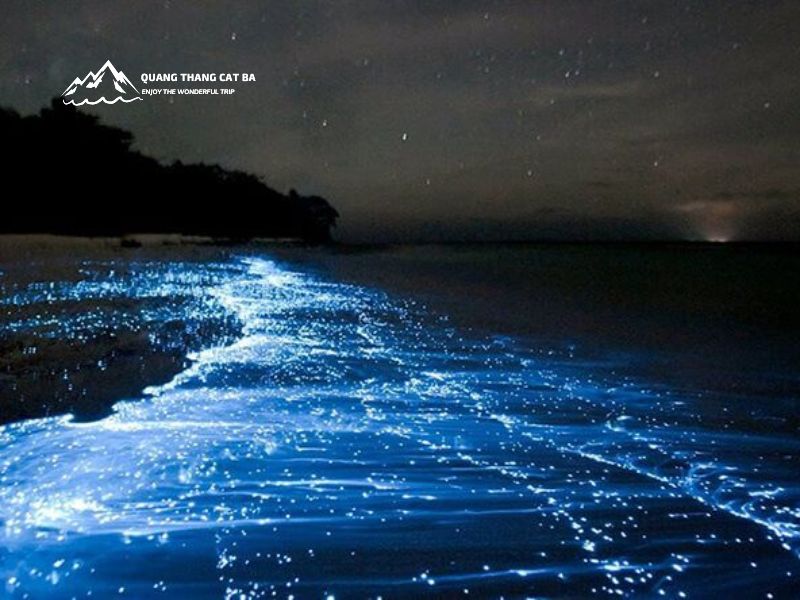
The Ocean’s Tiny Hearts
These plankton are the first spark of life in the sea.
- Phytoplankton are like floating plants, using sunlight to produce oxygen and nutrients.
- Zooplankton, their animal counterparts, feed on them and pass energy up the food chain — from small fish to majestic reef creatures.
They are tiny, but together, they build the entire web of marine life in Lan Ha Bay.
The Day and Night Symphony
During daylight, phytoplankton fill the water with energy, colouring the bay in subtle shades of jade and blue.
As night falls, zooplankton begin to drift closer to the surface — and that’s when the magic happens. Some of them, especially bioluminescent plankton, produce a soft blue-green light when disturbed.
A gentle stroke of your paddle, or even a curious fish swimming past, sets off thousands of sparkles — a natural fireworks display beneath the waves.
Why Lan Ha Bay Glows So Brightly
Lan Ha Bay’s waters remain clear and alive thanks to:
|
Factor |
Effect on Plankton |
|
Warm, nutrient-rich water |
Ideal conditions for phytoplankton to grow year-round |
|
Sheltered environment |
Gentle currents keep plankton concentrated near the surface |
|
Low pollution & fewer boats |
Allows bioluminescent species to thrive naturally |
|
Protected ecosystem |
Ensures a balanced food web supporting rich biodiversity |
These conditions create a safe haven where plankton flourish — proof of a healthy, living bay.
An Experience You’ll Never Forget
Imagine this: you’re kayaking at night, the sea completely still. Then, with one soft sweep of your paddle, the water explodes into shimmering light — as if stars have fallen beneath your boat.
This isn’t magic; it’s nature at its most delicate and perfect.
The bioluminescent plankton light up through a chemical reaction called luciferin–luciferase, glowing only when touched. It’s a sign of purity, of balance, of life thriving in harmony.
The Heartbeat of a Living Bay
Every flicker you see at night began with sunlight captured by phytoplankton during the day.
This invisible connection — sunlight to plankton, plankton to fish, fish to coral — is what keeps Lan Ha Bay vibrant and full of life.
Those glowing waves you’ll see on your night tour aren’t just beautiful; they’re the heartbeat of the entire ecosystem.
If you ever join a night kayaking tour in Lan Ha Bay, let your guide show you where the waters glow the brightest. Dip your hand gently into the water and watch the plankton respond — a dance of light between you and the sea.
Why Lan Ha Bay Is a Perfect Home for Plankton
If you ask any local guide why plankton thrive so abundantly in Lan Ha Bay, the answer is simple — the bay’s natural rhythm is perfectly balanced. With warm waters all year round, gentle currents, and plenty of sunlight, this serene environment becomes a living paradise for both phytoplankton and zooplankton.
Unlike many coastal areas where heavy waves and pollution disrupt marine life, Lan Ha Bay remains calm and crystal-clear. The still water allows sunlight to penetrate deeply, creating ideal conditions for phytoplankton to photosynthesise and multiply — the foundation of the bay’s entire food web.
A Tranquil Contrast to Halong Bay
Lan Ha Bay is often described as Halong’s quieter, purer sibling. While Halong Bay attracts crowds and constant boat movement, Lan Ha’s sheltered lagoons and fewer tourist vessels mean less noise and disturbance.
This peace is exactly what plankton love. In these calmer, cleaner waters, bioluminescent plankton thrive undisturbed, producing that breathtaking blue-green glow on dark nights. It’s no surprise many visitors say the glowing waves of Lan Ha feel more natural, more alive, and far less commercial than anywhere else nearby.
Nature’s Support System: Mangroves and Coral Reefs
Two key guardians keep Lan Ha’s waters rich and healthy:
|
Ecosystem |
Contribution to Plankton Growth |
|
Mangrove Forests |
Act as natural filters, trapping sediment and releasing organic matter that nourishes plankton. |
|
Coral Reefs |
Support diverse marine species and recycle nutrients that sustain phytoplankton and zooplankton. |
Together, these ecosystems form a nutrient loop — mangroves feed the water, coral reefs protect it, and plankton give life back in return.
A Living Sanctuary for the Smallest Creatures
Because Lan Ha Bay is protected and still relatively untouched by industrial activity, its plankton populations remain healthy and stable. The bay’s nutrient balance, temperature, and low light pollution make it one of Vietnam’s most pristine environments for marine microorganisms.
This invisible world of plankton quietly supports everything visitors come to see — from colourful coral gardens to schools of tropical fish, and of course, the unforgettable bioluminescent glow at night.
So when you drift under the stars on a kayak, watching the water shimmer beneath your paddle, remember — it’s not just beauty you’re seeing. It’s the delicate harmony of an ecosystem that has been thriving here for thousands of years.
The Two Main Types of Plankton You’ll Find Here
Phytoplankton – The Ocean’s Tiny Green Farmers
When you look down into the clear waters of Lan Ha Bay, you’re seeing more than just reflections of limestone cliffs — you’re gazing into a living garden beneath the sea. Here, phytoplankton — the “tiny green farmers of the ocean” — work tirelessly, using sunlight to create energy through photosynthesis.
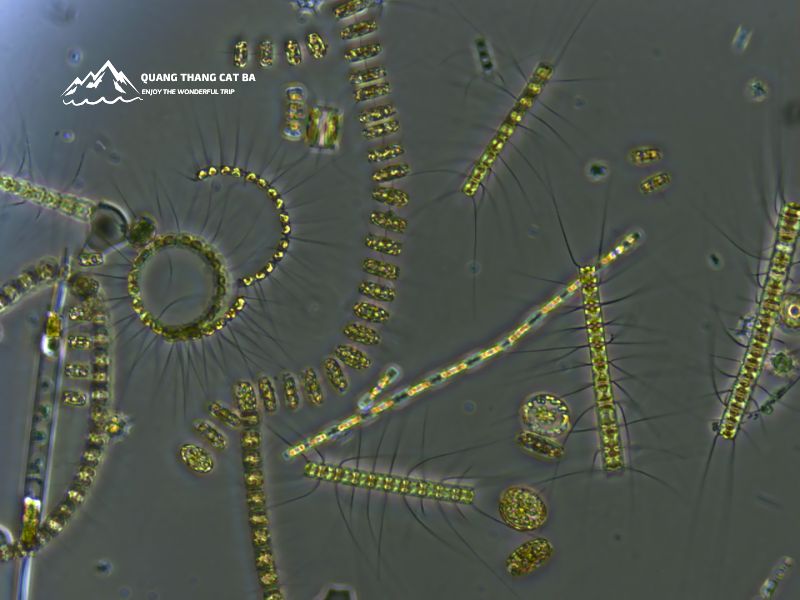
They are the “trees of the sea,” producing oxygen, absorbing carbon, and nurturing life from the surface down to the coral reefs below. The most common types in these waters are diatoms (tiny algae with silica shells) and dinoflagellates (microscopic algae with tail-like structures that help them move).
It’s thanks to these microscopic beings that the waters of Lan Ha shimmer in shades of emerald and turquoise. Their photosynthetic activity not only colours the bay but also forms the first link in the marine food chain — feeding zooplankton, fish larvae, and countless other creatures that call the bay home.
In every drop of water you see glistening under the sun, thousands of phytoplankton are at work, turning light into life.
Zooplankton – The Microscopic Wanderers
As day turns to dusk, the bay’s second great community awakens — the zooplankton, or as locals affectionately call them, “the ocean’s tiny wanderers.”
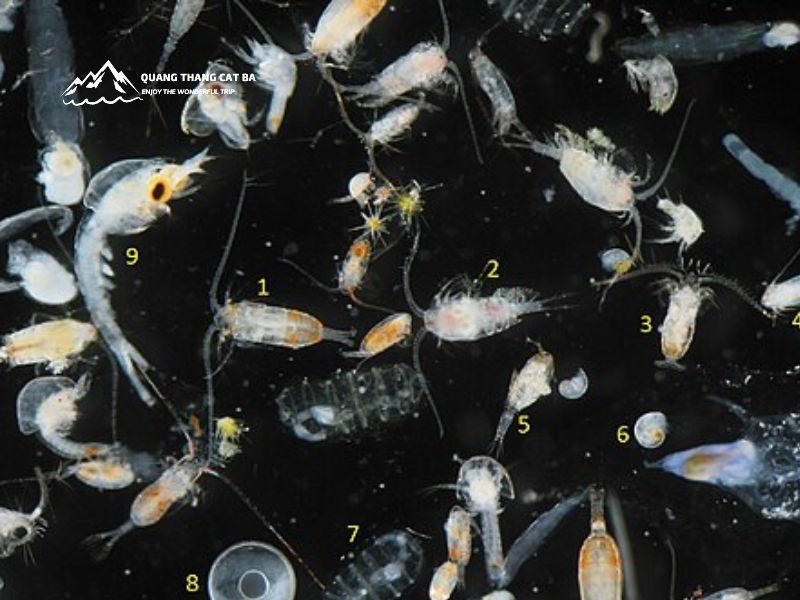
These are not plants but minute drifting animals, moving gently with the current. Among them are copepods, fish larvae, and small crustaceans, invisible to the naked eye but vital to the ecosystem. They feed on phytoplankton and, in turn, sustain larger marine species like jellyfish, squid, and young reef fish.
If phytoplankton are the farmers, zooplankton are the travellers and storytellers of the sea — carrying the energy of sunlight from one creature to another. Without them, the entire marine web would fall apart.
A Perfect Balance Beneath the Surface
Together, these two groups — phytoplankton and zooplankton — create a delicate balance that defines Lan Ha Bay’s underwater world. Their abundance fuels coral reefs, sustains diverse fish populations, and even gives rise to the magical bioluminescent glow that enchants night-time visitors.
So, the next time you’re kayaking through the bay or watching the water sparkle under the moonlight, remember — you’re witnessing the work of millions of tiny life forms, each playing their part in keeping this ecosystem alive and thriving.
The Magical Glow — Bioluminescent Plankton of Lan Ha Bay
On calm, moonless nights, when the sea in Lan Ha Bay turns into a soft mirror of the sky, something extraordinary begins to happen. With just a gentle stroke of your kayak paddle, the water beneath you suddenly lights up — a thousand tiny sparks of blue-green light swirl and shimmer in the darkness. This breathtaking scene is created by bioluminescent plankton, nature’s living lanterns, and one of the bay’s most enchanting secrets.
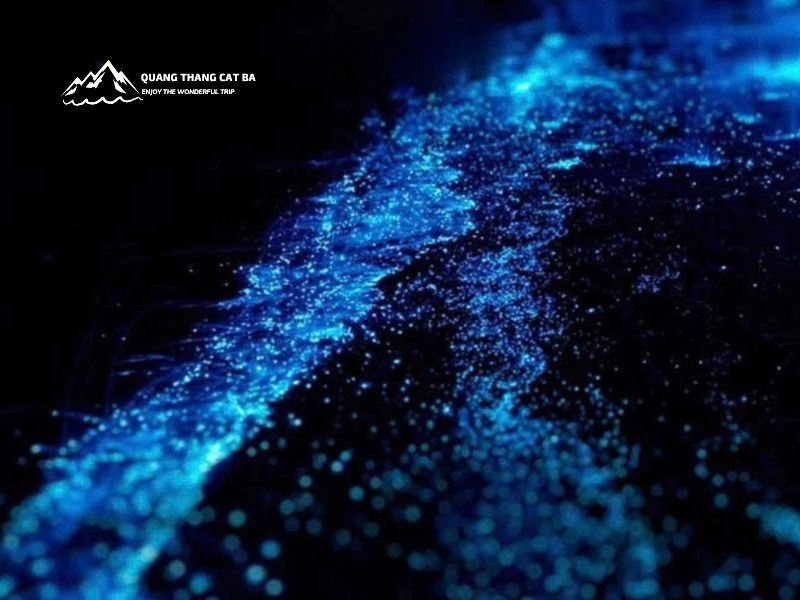
The Science Behind the Glow
The glow isn’t magic, though it feels like it. It’s the result of a biochemical reaction involving two key substances — luciferin and luciferase. When the water is disturbed, the enzyme luciferase reacts with luciferin in the presence of oxygen, releasing light but no heat.
This reaction happens in microscopic marine organisms known as dinoflagellates — a type of phytoplankton capable of glowing when agitated. Their light is a defence mechanism, thought to startle predators or attract bigger ones to scare them away. What we see, however, is a surreal, glowing dance that seems to breathe with the ocean’s rhythm.
When and Where to See the Phenomenon
The best time to witness bioluminescent plankton in Lan Ha Bay is from May to August, when the waters are warm and calm. During this period, the plankton population thrives, and the light show becomes especially vivid.
The most dazzling displays occur on dark, moonless nights with little wind or current — perfect conditions for the plankton to float near the surface. Two spots are particularly famous among local guides:
|
Location |
What Makes It Special |
|
Ba Trái Đào Area |
Sheltered, quiet waters ideal for glowing plankton activity. |
|
Vạn Bội Lagoon |
Calm, shallow zones with minimal boat traffic — excellent visibility. |
Many night kayaking tours include these areas in their routes, letting visitors experience the glow up close — some even describe it as “paddling through liquid stars.”
A Living Indicator of a Healthy Sea
Beyond its beauty, this phenomenon signals something profound — a thriving and balanced marine ecosystem. Bioluminescent plankton flourish only in clean, nutrient-rich waters. The glow you see is proof that Lan Ha Bay remains one of the few places in northern Vietnam where nature still breathes freely.
When you witness this spectacle, you’re not just seeing light — you’re watching the heartbeat of the bay itself, pulsing with life from the smallest organisms that sustain its vast underwater world.
How the Seasons and Waters Shape Plankton Life in Lan Ha Bay
If you spend enough time exploring Lan Ha Bay, you’ll realise that the water never looks the same twice. Its colour, clarity, and even the glow beneath its surface shift with the rhythm of the seasons — and at the heart of these changes lies plankton, the bay’s most sensitive and fascinating residents.
Rainy Season – When the Bay Comes Alive
During the rainy months, fresh water and nutrients flow into the bay from the surrounding limestone mountains and mangrove forests. This nutrient surge acts like fertiliser for phytoplankton, leading to what scientists call a “plankton bloom.”
The result? The water turns slightly greener and cloudier, filled with microscopic life. It’s a sign of abundance — fish feed more actively, coral reefs thrive, and the entire ecosystem hums with energy. While visibility may be lower for snorkellers, this period reveals how productive Lan Ha’s marine world truly is.
Dry Season – The Time of the Glowing Sea
As the rain fades and the dry months arrive, the bay transforms again. The water becomes crystal clear and calmer, with fewer nutrients but higher transparency. Though plankton numbers drop slightly, this is when their bioluminescent beauty shines brightest.
On dark, moonless nights, tiny bioluminescent plankton — mostly dinoflagellates — drift near the surface. Each paddle stroke or wave sends sparks of light across the water, forming glowing trails that dance around kayaks.
Many visitors say it feels like paddling through starlight, a truly unforgettable moment that captures the living magic of the bay.
|
Season |
Water Conditions |
Plankton Activity |
Best Experience |
|
Rainy Season (May–Oct) |
Warm, nutrient-rich, slightly murky |
Strong phytoplankton growth |
Rich biodiversity, fish activity |
|
Dry Season (Nov–Apr) |
Clear, calm, low nutrient flow |
Fewer plankton but stronger glow |
Night kayaking with bioluminescence |
A Guide’s Tip for the Perfect View
Local guides often whisper to guests: “Look closely at the surface — not too fast.” When your paddle glides gently through the dark water, the plankton’s light flickers softly, like constellations scattered beneath your boat.
If you’re planning to see this phenomenon, the best viewing time is during the dry season, especially between May and August, around the new moon when the sky is darkest and the bay is calmest.
Whether it’s the nutrient-rich rains of summer or the clear serenity of winter, every season tells a different story about what types of plankton are present in Lan Ha Bay — each one a delicate balance between sunlight, water, and life itself.
More explore: Lan Ha Bay Night Kayaking to see plankton
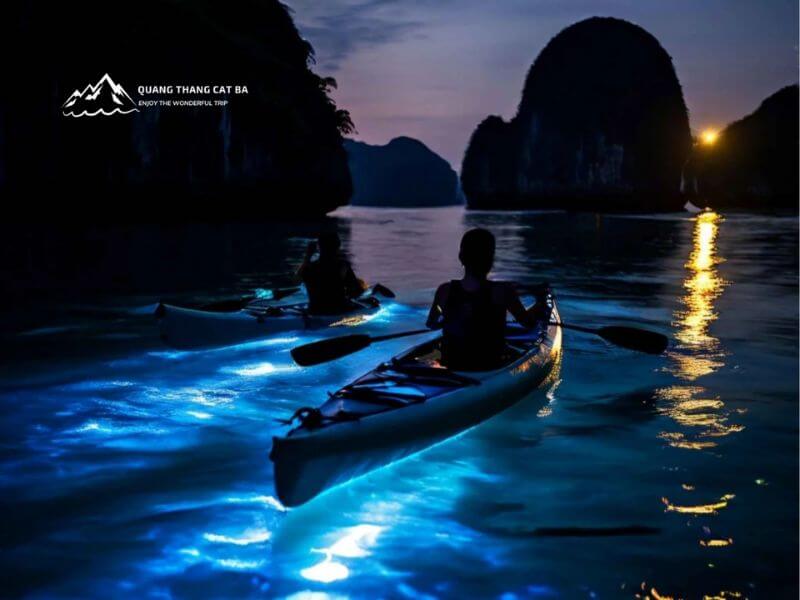
What Makes Lan Ha’s Plankton Special Compared to Halong Bay
If you’ve ever visited both Lan Ha Bay and Halong Bay, you’ll quickly sense the difference — not just in the scenery, but in the very feeling of the water. Lan Ha is quieter, cleaner, and somehow more alive beneath the surface. For plankton, these conditions are perfect.
While Halong Bay bustles with large cruise ships and constant activity, Lan Ha Bay remains a peaceful refuge, protected by hundreds of limestone islands that block strong winds and waves. The result is a stable, undisturbed environment where plankton populations — especially bioluminescent species — can thrive naturally.
Why Lan Ha Bay Creates the Ideal Conditions
|
Factor |
Lan Ha Bay |
Halong Bay |
|
Boat Traffic |
Fewer vessels, calmer waters |
Heavy traffic, frequent engine disturbance |
|
Water Quality |
Clear, low pollution |
More industrial and tourist impact |
|
Wind Exposure |
Sheltered by island clusters |
More open, stronger winds |
|
Plankton Activity |
Stable growth, stronger glow |
Disturbed habitats, less visible glow |
Because of this balance, Lan Ha’s plankton remain healthier and more concentrated, creating brighter and more consistent displays of light. On a dark night, the bay’s water often glows like liquid sapphire — a living light show unseen in most parts of Halong.
A Natural Laboratory Beneath the Night Sky
Locals often describe Lan Ha as “a natural laboratory that tourists can step into each night.” It’s a place where science meets wonder — where you can witness the delicate dance between plankton, water, and light in its purest form.
Kayaking quietly through these calm waters, you may notice how even the smallest motion — your paddle dipping, a fish darting by — awakens a swirl of radiant blue. It’s not only beautiful; it’s living proof of an ecosystem still intact.
A Haven for Eco-Travellers
Lan Ha’s unspoiled waters reflect what makes sustainable tourism so important. The glow of bioluminescent plankton here is a reminder that when nature is left undisturbed, it rewards us with breathtaking moments few places on earth can match.
So, while Halong offers grandeur and scale, Lan Ha Bay offers intimacy and authenticity — an experience where you don’t just see the bay, you feel its life pulsing around you.
Tips for Travellers — When & Where to See Them Best
If you’re hoping to catch the magical glow of bioluminescent plankton in Lan Ha Bay, timing and location make all the difference. The phenomenon is delicate — invisible during the day yet breathtakingly vivid under the right conditions.
Best Time to Witness the Glow
The most enchanting time to see the plankton light up is on moonless nights, ideally between 19:00 and 21:00, when the sky is at its darkest. From May to September, the bay’s warm, calm waters provide the perfect environment for plankton activity.
During this season, the water surface is smooth like glass — each paddle stroke releases a trail of blue-green sparks, glowing and fading like living starlight beneath your kayak. The experience feels almost surreal, as if the sea itself is breathing light.
How to Experience It
The best way to immerse yourself in this spectacle is to join a night kayaking tour or a dedicated plankton-watching tour. These small-group tours usually depart from Cat Ba Island, taking travellers into the quieter corners of Lan Ha Bay, away from bright harbour lights.
Some of the most recommended areas include:
|
Location |
Why It’s Ideal |
|
Ba Trái Đào (Three Peaches) |
Calm, enclosed waters with minimal boat movement. |
|
Vạn Bội Lagoon |
Shallow and dark, allowing the glow to appear clearly. |
Local guides will often ask you to switch off all flashlights and simply stir the water gently with your paddle. Even a light touch can awaken thousands of tiny sparks, turning the black sea into a swirling galaxy beneath you.
Insider Tips from Local Guides
- Avoid using strong lights: Flashlights or phone torches can disrupt the plankton’s natural reaction.
- Choose a calm, clear night: The less moonlight and wind, the stronger the bioluminescence.
- Bring minimal gear: Waterproof phone pouches or low-light cameras work best for photos.
- Trust your guide: They know where the glow appears strongest and will navigate you to those hidden spots.
The best part? You don’t need any special equipment — just curiosity and patience. As you drift in silence, you’ll see how every ripple, every paddle movement, sets the water alight. It’s one of those rare natural wonders that feels both intimate and infinite.
So if you’re wondering what types of plankton are present in Lan Ha Bay, remember: among them are the tiny dinoflagellates that gift this serene bay its most unforgettable nighttime glow.
FAQs About Plankton in Lan Ha Bay
What types of plankton are present in Lan Ha Bay?
In Lan Ha Bay, the waters are teeming with two main groups of plankton — phytoplankton and zooplankton.
Phytoplankton, often called “the ocean’s green lungs,” include diatoms (tiny algae with glass-like shells) and dinoflagellates (microscopic organisms that can glow in the dark). These are the same plankton that paint the bay’s surface in subtle shades of emerald during the day and light it up like a dream at night.
Zooplankton, on the other hand, are the small drifting animals — copepods, fish larvae, and tiny crustaceans — that feed on phytoplankton and provide the foundation for the bay’s rich marine life. Together, they form the invisible but vital engine of Lan Ha’s underwater world.
Is the glowing plankton safe for humans?
Yes, absolutely! The bioluminescent plankton found in Lan Ha Bay are completely safe to touch, swim, or kayak among. Their magical glow comes from a harmless chemical reaction between luciferin and luciferase — natural substances that create light without producing heat.
You can dip your hand in the water, swirl it gently, and watch the glow ripple through your fingers — a once-in-a-lifetime experience that’s as safe as it is spectacular. Local guides even encourage this simple interaction, as long as visitors avoid using harsh lights or chemicals.
Why does the water glow brighter in Lan Ha than in Halong Bay?
The answer lies in Lan Ha Bay’s calm and cleaner environment. Unlike Halong Bay, which welcomes hundreds of large cruise ships daily, Lan Ha is quieter, less polluted, and more protected. Its shallow waters, surrounded by limestone islands, shield it from strong winds and waves — the ideal habitat for bioluminescent plankton to flourish.
Think of Lan Ha as a natural open-air laboratory, where the sea remains undisturbed enough for visitors to see nature’s chemistry come alive. This combination of peace, purity, and balance makes the glow here more vivid than almost anywhere else in northern Vietnam.
When is the best time to see bioluminescent plankton?
The best time to witness the glowing plankton is on moonless nights between 19:00 and 21:00, particularly from May to September. During these warm, calm months, the plankton gather near the surface and react beautifully to gentle motion in the water.
Guides recommend choosing a new moon night for the clearest view — when the sky is darkest, the air is still, and every paddle stroke lights up a glowing path. The experience is most vivid during night kayaking tours around quiet areas such as Vạn Bội Lagoon and Ba Trái Đào, where the water stays undisturbed and the glow dances freely beneath the stars.
Whether you’re a marine enthusiast or just a traveller chasing unforgettable moments, the plankton of Lan Ha Bay reveal a side of nature that feels almost otherworldly — delicate, glowing, and utterly alive.
Conclusion — Discover Lan Ha Bay’s Living Light with Quang Thắng Cát Bà
Now that you’ve learned what types of plankton are present in Lan Ha Bay, there’s only one thing left to do — come and see their glowing beauty for yourself. Beneath the still surface of this quiet bay lies a living masterpiece of light and life, waiting to be experienced up close.
At Quang Thắng Cát Bà, we offer authentic local tours designed to help you witness this wonder of nature in the most intimate way possible. You can choose from a range of programs tailored to your time and travel style:
- Lan Ha Bay tour from Hanoi – full-day cruise with seafood lunch & kayaking.
- Ha Long Bay tour from Cat Ba – explore the UNESCO World Heritage waters.
- Lan Ha Bay half day tour – ideal for sunset chasers and short stays.
- Lan Ha Bay plankton tour – night kayaking to see the glowing sea.
- Lan Ha Bay 2 days 1 night cruise – sleep under the stars, surrounded by silence.
- Cat Ba 3 days 2 nights tour – discover the island’s highlights by land and sea.
- Hanoi to Cat Ba bus & Ninh Binh to Cat Ba bus – comfortable transfers directly to the island.
Join us for a journey where science meets wonder — where every paddle stroke reveals the shimmering life beneath.
Let Quang Thắng Cát Bà be your trusted local guide to the glowing heart of Lan Ha Bay.

